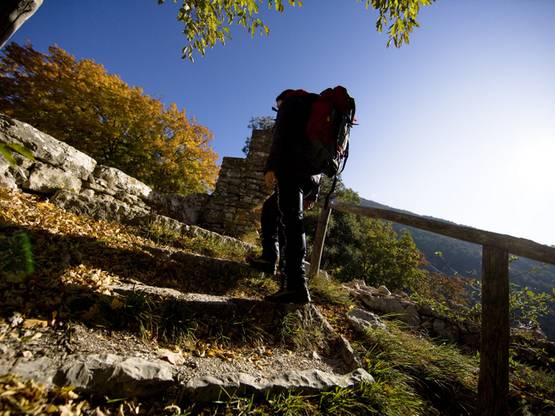The Via dei Monti Lariani (The Larian Mountains Trail) is a hiking route that is part of the Lombardy stretch of the “Sentiero Italia”, the Grand Italian Trail, about 6,000 km long, extending all the way through Italy. The Via dei Monti Lariani is about 125 km long and consists mainly of paths and mule tracks. It connects Cernobbio with Sorico (for easy accessibility by train the departure has been set in Como), going along the western side of Lake Como at altitude. The track, although recently set up, has a rich history. Over the last centuries it saw quite heavy traffic of mountain products which were bound for the provincial capital, Como. Very many of these places, situated in a band of altitude varying between 600 and 1200 metres, were the mid-season mountain pastures (called “mûnt” in dialect) used by the population on the shores of the lake as places to take their livestock in spring and autumn (in summer they went towards the “alp”, locations higher up the mountains). The name “Via dei Monti Lariani” was chosen precisely to celebrate the pathway connecting these ancient settlements, which are partly still active and partly abandoned or destroyed by time.
In the last century the Via also had some strategic importance, since it is situated in border country. During the First World War, some sections of the route, in the areas between Monte Bisbino and Sasso Gordona, were chosen for the construction of roads and military structures to support the famous Cadorna Line (the defensive military line built between 1911 and 1916 in the Lombard Prealps, with the purpose of protecting Italian territory and the industrial centres of Milan and Bergamo from a hypothetical German attack through neutral Switzerland). In addition, in some of the border locations touched by the Via, Customs Police barracks were built to control the extensive traffic in various contraband goods to the Canton of Ticino. These still exist today, but almost all of them have been transformed into Rifugi (refuges or mountain huts) of the CAI (the Italian Alpine Club). The Via dei Monti Lariani has, however always been used principally as a commercial route complementary to the main Strada Regina, the route that ran from Como to Samolaco (on the shore of the lake) and continued on towards Switzerland through the Julier/Septimer Passes or the Splügen Pass. Parallel to this way is the legendary Via Regina, the fundamental route for traffic from Italy to northern Europe, which seems to have already been used in Romans times. The commercial importance and intense use of the road, ever since ancient times, is also corroborated by the remains of many hospitales and xenodochia along the way. In the Middle Ages, the numerous xenodochia were places that offered hospitality to wayfarers and pilgrims travelling the road, and were generally run by monks under the direction of a “Minister”; while hospitales were devoted to caring for the sick. In the course of the years this distinction disappeared, so that either word was used to describe places where travellers could stay. Still visible with its original features is the hospitalis of Santa Maria Maddalena di Stabio in Ossuccio, made famous by the unusual bell tower of its oratory, which is in a hybrid Moorish-Gothic style grafted onto an old Romanesque structure. The Strada Regina has therefore always been the main historical trade route along the lake. So why not simply make our hiking trail follow it? The answer is obvious. The Via Regina today is a narrow state road carrying a heavy load of traffic, absolutely unsuitable, indeed dangerous, for people travelling on foot. As happens with other walking trails (for example some sections of the famous Camino de Santiago de Campostela) we have chosen first and foremost to care for the safety of our “modern wayfarers”, opting for a less historic route, such as that of the Via dei Monti Lariani, but one which is much more enjoyable for tourists.
